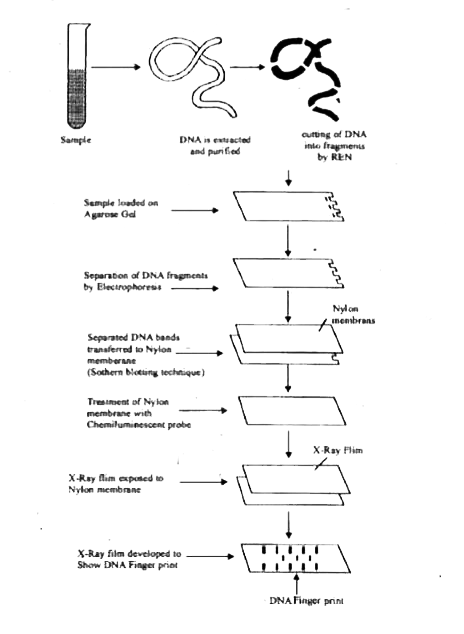Briefly explain the steps involved in DNA finger printing?Solution in Kannada
This is a technique which hamna in the camblishment of the identity of a person by detecting and comparing specific nucleotide sequences in DNA of individuals. This technique was developed by Alec Joffroys and his associates.
Steps: a. Collection of sample: Sample like blood, semen, hair, saliva or any other tissue even in the dried state are collected.
b. Extraction of DNA: The material collected is subjected to high speed centrifugation which separates the DNA from the cell.
c. Fragmenting DNA: The DNA in the sample is treated with restriction endonucleases to obtain smaller restriction fragments.
d. Separating DNA fragments: The smaller fragments of DNA are made to run on an agarose gel plate by electrophoresis technique in which depending on molecular size and shape, the nucleotides produce distinct bands in the gel.
e. Extracting DNA from gel: The double stranded DNA fragment in the gel it denatured into single strands by exposing the gel into an alkaline solution (NaOH). Then by Southern blotting technique, these single stranded DNA fragments are transferred onto a nitrocellulose filter or a nylon membrane.
f. Tagging radioactive probes: A probe is radio actively labelled synthetic DNA. The nitrocellulose filter is now incubated with these radioactive probes. The probes act as specific nucleotide detectors and binds or hybridises with the specific nucleotides present in DNA fragments on the filter.
g. Auto radiography: An x-ray film is placed on the filter to obtain autoradiographic prints.The film is then processed to observe visible hybridised pattern of bands. This is the genetic finger print or DNA finger print.
h. Comparison: Comparison of two genetic finger prints with great care can provide information about the degree of similarities or differences.

Topper's Solved these Questions
- BOOK - SUBHASH PUBLICATIONCHAPTER - MOLECULAR BASIS OF INHERITANCEEXERCISE - THREE MARKS QUESTION2videos
MOLECULAR BASIS OF INHERITANCE
- BOOK - SUBHASH PUBLICATIONCHAPTER - MODEL QUESTION PAPER 3EXERCISE - PART -D10videos
MODEL QUESTION PAPER 3
- BOOK - SUBHASH PUBLICATIONCHAPTER - ORGANISMS AND POPULATIONS EXERCISE - FIVE MARK QUESTION AND ANSWER6videos
ORGANISMS AND POPULATIONS
Similar Questions
How is nucleosome formed? Draw a diagram of the nucleosome.
01:49View SolutionDraw a neat diagrammatic view of the male reproductive system.
01:37View SolutionWhat are adaptations ? Discess any four adaptations found in plants and animals.
View SolutionWhich step does not involve in DNA finger printing
View SolutionWhich step is not correct in DNA finger printing-
05:30View SolutionA DNA finger printing process involves :-
View SolutionA DNA finger printing process involves :-
02:16View SolutionExplain the steps involved in DNA finger printing?
02:02View SolutionExplain about DNA finger printing process.
05:27View SolutionDNA finger printing involves the use of
03:46View SolutionDNA finger printing involves
02:02View SolutionExplain southern blotting technique of DNA finger printing.
View SolutionExplain briefly the steps involved in DNA fingerprinting.
01:11View SolutionDNA finger printing involves
03:56View SolutionWhat is DNA finger printing? What are the applications of DNA finger printing?
View Solution

